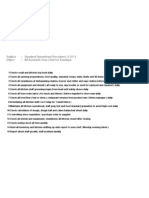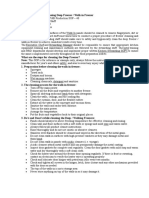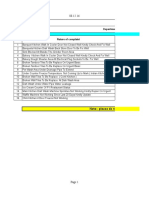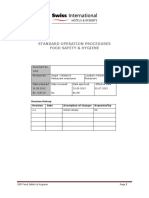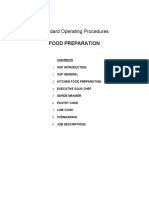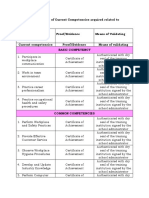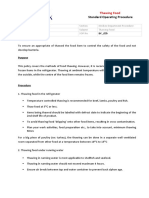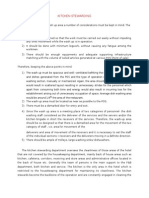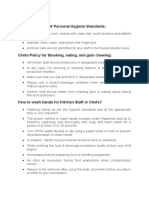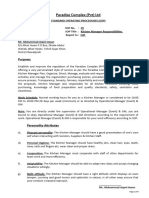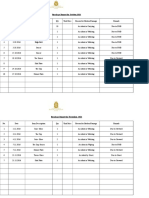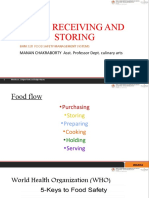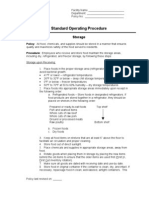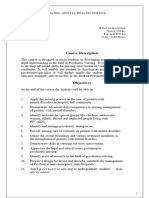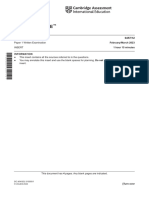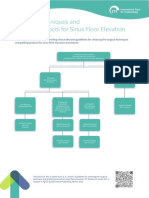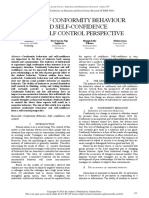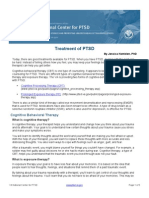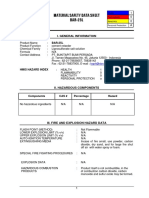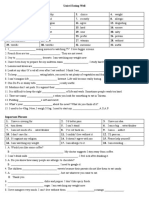SOP Storage
SOP Storage
Uploaded by
JessCopyright:
Available Formats
SOP Storage
SOP Storage
Uploaded by
JessOriginal Title
Copyright
Available Formats
Share this document
Did you find this document useful?
Is this content inappropriate?
Copyright:
Available Formats
SOP Storage
SOP Storage
Uploaded by
JessCopyright:
Available Formats
Facility Name ________________________
Department: _________________________
Policy No: __________________________
Standard Operating Procedure
Storage
Policy: All food, chemicals, and supplies should be stored in a manner that ensures
quality and maximizes safety of the food served to residents.
Procedure: Employees who receive and store food maintain the storage areas,
including dry, refrigerated, and freezer storage, by following these steps:
Storage upon Receiving:
1. Place foods in the proper storage area (refrigerator or freezer) quickly to
avoid bacterial growth.
• 41°F or lower – refrigerator temperatures
• 26°F to 32°F or below – deep chill storage temperatures
• 0°F or below – freezer temperatures
• 50°F to 70°F at 50 to 60% humidity – dry storage temperatures
2. Place foods into appropriate storage areas immediately upon receipt in
the following order:
a. Refrigerated foods – Store foods in designated refrigerators. If
food products are stored together in a refrigerator, they should be
placed on shelves in the following order:
Prepared or ready-to-eat foods Top shelf
Fish and seafood items
Whole cuts of raw beef
Whole cuts of raw pork
Ground or processed meats
Raw poultry Bottom shelf
b. Frozen foods
c. Dry foods
3. Keep all food items on shelves that are at least 6” above the floor to
facilitate air circulation and proper cleaning.
4. Store food out of direct sunlight.
5. Place chemicals and supplies in appropriate storage areas, away from
food.
6. Rotate goods when placing them in storage by placing the new items
behind the old items to ensure that the older items are used first (First In,
First Out inventory rotation).
7. Make sure all goods are dated with receiving date and use-by date.
8. Store food in original container if the container is clean, dry, and intact. If
necessary, repackage food in clean, well-labeled, airtight containers. This
Policy last revised on: ______
Facility Name ________________________
Department: _________________________
Policy No: __________________________
Standard Operating Procedure
can also be done after a package is opened. Food is NEVER put in chemical
containers and chemicals are NEVER placed in food storage containers.
Policy last revised on: ______
Facility Name ________________________
Department: _________________________
Policy No: __________________________
Standard Operating Procedure
Storage, continued
9. Store potentially hazardous foods no more than 7 days at 41ºF from date
of preparation.
10. Store pesticides and chemicals away from food handling and storage
areas. They must be stored in original, labeled containers.
Storeroom Sanitation:
1. Maintain clean and uncluttered storage areas. Storage areas should be
positioned to prevent contamination from areas where garbage is stored.
2. Dispose of items that are beyond the expiration or “use by” dates.
3. Store all items on shelves that are at least 6” above the floor to facilitate air
circulation and proper cleaning.
4. Check for signs of rodents or insects. If there are signs of the presence of
rodents or insects, notify the foodservice manager.
Temperature Control:
1. Check the temperature of all refrigerators, freezers, and dry storerooms at the
beginning of each shift. This includes both internal and external
thermometers, where appropriate.
• Refrigerator temperatures should be between 36ºF and 41ºF.
• Freezer temperatures should be between -10ºF and 0ºF.
• Storeroom (dry storage) temperatures should be between 50ºF and 70ºF.
2. Record temperatures on the appropriate temperature log and initial.
3. Take corrective actions if temperatures are out of the recommended range.
4. Do not overload refrigerated storage areas, as this prevents air flow and
makes the unit work harder to stay cold.
5. Use caution when cooling hot food in the refrigerator, as this warms the unit
and can put other foods into the temperature danger zone.
6. Keep units closed as much as possible to maintain proper temperatures.
7. Defrost all units on a regular schedule to aid in proper maintenance and air
circulation.
The foodservice manager will:
1. Check logs and temperature of storage rooms, freezers, and refrigerators.
2. Review logs to make sure there are no temperature deviations.
3. Document all corrective action taken on the appropriate forms.
4. File logs with HACCP records.
Policy last revised on: ______
You might also like
- Kitchen Opening Closing ChecklistDocument14 pagesKitchen Opening Closing ChecklistZubair Anwar50% (2)
- SOP - VegetableDocument9 pagesSOP - VegetableBoopathi ChinnaduraiNo ratings yet
- SOP For Ass Sous ChefDocument1 pageSOP For Ass Sous Chefanon-295442100% (3)
- Daily Kitchen Checklist: Daily or After Each Use InitialsDocument1 pageDaily Kitchen Checklist: Daily or After Each Use InitialsAnonymous AEEGYnX100% (1)
- Handbook of Microbiological Criteria for FoodsFrom EverandHandbook of Microbiological Criteria for FoodsNo ratings yet
- SOP Food ProductionDocument10 pagesSOP Food ProductionAnandh67% (3)
- Kitchen Inspection ChecklistDocument8 pagesKitchen Inspection ChecklisttzryadNo ratings yet
- Pcad - Opening & Closing ProceduresDocument2 pagesPcad - Opening & Closing ProceduresJo-an RaagasNo ratings yet
- SOP For Receiving of Food and Raw Materials in KitchenDocument2 pagesSOP For Receiving of Food and Raw Materials in KitchenAmgad saqr100% (5)
- Stewarding SOP For Cleaning Deep Freezer Walk-In FreezerDocument1 pageStewarding SOP For Cleaning Deep Freezer Walk-In FreezerAmgad saqrNo ratings yet
- HACCP ManualDocument24 pagesHACCP ManualSanchit kanwar100% (3)
- Sop Store Room SafetyDocument4 pagesSop Store Room SafetyamirNo ratings yet
- SOP StorageDocument2 pagesSOP StorageAnikBudiany0% (2)
- Kitchen Snag ListDocument2 pagesKitchen Snag Listayan mitra100% (4)
- SOP Food Safety Hygiene 17 - 06Document38 pagesSOP Food Safety Hygiene 17 - 06Rama Karunagaran100% (1)
- Kitchen Policies 2Document8 pagesKitchen Policies 2MesakNo ratings yet
- Food Cost Control ChecklistDocument4 pagesFood Cost Control Checklistitsack100% (2)
- HACCP-Based SOP: Food Safety ChecklistDocument4 pagesHACCP-Based SOP: Food Safety ChecklistЕлена Коваленко100% (2)
- Standard Operating Procedures: Food PreparationDocument12 pagesStandard Operating Procedures: Food PreparationSheila Tuli50% (2)
- Food Safety ChecklistDocument4 pagesFood Safety Checklistjalali007No ratings yet
- Food Sanitation: Observing Personal Hygiene ElementsDocument5 pagesFood Sanitation: Observing Personal Hygiene ElementsHabade GauravNo ratings yet
- HACCP & Sanitation in Restaurants and Food Service Operations: A Practical Guide Based on the USDA Food CodeFrom EverandHACCP & Sanitation in Restaurants and Food Service Operations: A Practical Guide Based on the USDA Food CodeRating: 2 out of 5 stars2/5 (5)
- Form 4.2 Evidence of Current Competencies Acquired Related To Job or OccupationDocument2 pagesForm 4.2 Evidence of Current Competencies Acquired Related To Job or OccupationMay M Rodeo100% (4)
- SKILLFIRE OKR Facilitation KitDocument9 pagesSKILLFIRE OKR Facilitation KitTrường Thành NguyễnNo ratings yet
- SOP Receiving-DeliveriesDocument2 pagesSOP Receiving-DeliveriesErdinan Setiawan100% (1)
- Sop - Kitchen DepartmentDocument11 pagesSop - Kitchen DepartmentChef Chef100% (4)
- The Food Production FlowDocument120 pagesThe Food Production FlowTrisha Racho100% (1)
- Food Product FlowDocument55 pagesFood Product FlowAli Nah100% (1)
- KITCHENDocument5 pagesKITCHENgilbertmalcolmNo ratings yet
- Food Audit Checklist For KitchenDocument2 pagesFood Audit Checklist For KitchenArush BhatnagarNo ratings yet
- Daily Cleaning Checklist - Night - MKDocument4 pagesDaily Cleaning Checklist - Night - MKMohamed Mohzin Ghouse100% (2)
- Restaurant Opening and Closing Checklist PDFDocument7 pagesRestaurant Opening and Closing Checklist PDFNiniNo ratings yet
- Microsoft Word - Checklist For Cafeteria Inspection - LatestDocument1 pageMicrosoft Word - Checklist For Cafeteria Inspection - LatestAyong EntilyNo ratings yet
- 6 7 Basic Kitchen Opening and Closing Checks TemplateDocument2 pages6 7 Basic Kitchen Opening and Closing Checks TemplatedonexcelNo ratings yet
- Job Description Cook IDocument2 pagesJob Description Cook IYogie Si el'NinoNo ratings yet
- Purchasing, Receiving, Handling and Storage of Meat GuidlinesDocument16 pagesPurchasing, Receiving, Handling and Storage of Meat Guidlinesthei riosNo ratings yet
- Sop KitchenDocument14 pagesSop Kitchenpolicecollege sihalaNo ratings yet
- Washing Fruits and VegetablesDocument2 pagesWashing Fruits and VegetablesSaravana Kumar100% (1)
- CookDocument3 pagesCookImee S. YuNo ratings yet
- 15.kitchen (Steward 2) 274 302Document29 pages15.kitchen (Steward 2) 274 302mackybhoyamores100% (1)
- Restaurants Checklist V3Document7 pagesRestaurants Checklist V3AzharNo ratings yet
- Food Safety Officer Report Kitchen (AutoRecovered)Document15 pagesFood Safety Officer Report Kitchen (AutoRecovered)athiebviviendaNo ratings yet
- Fridge and Freezer Temperature Log SheetDocument2 pagesFridge and Freezer Temperature Log Sheetkent kenny100% (1)
- SOP Facility and Equipment HygieneDocument6 pagesSOP Facility and Equipment HygieneHenry Taguma100% (2)
- Receiving DeliveriesDocument3 pagesReceiving Deliveriesklutgring100% (1)
- Kitchen Station Task ListDocument9 pagesKitchen Station Task Listmaity.20053667No ratings yet
- Thawing FoodDocument2 pagesThawing FoodAddress Hotel100% (1)
- Manager Closing Checklist: Front Counter / Cash Cooks LineDocument4 pagesManager Closing Checklist: Front Counter / Cash Cooks LineApepzuhdi100% (2)
- Sunnyside HACCP Plan 2012V1.2Document42 pagesSunnyside HACCP Plan 2012V1.2fisherkiddNo ratings yet
- Kitchen Stewarding - Facility PlanningDocument20 pagesKitchen Stewarding - Facility Planninglaksh100% (3)
- Kitchen Staff Personal HygieneDocument3 pagesKitchen Staff Personal HygieneKatrina ZaiNo ratings yet
- SOP Cleaning and Sanitizing - 2!15!16Document3 pagesSOP Cleaning and Sanitizing - 2!15!16Kenneth Paul OlinanNo ratings yet
- SOPs of Kitchen ManagerDocument8 pagesSOPs of Kitchen Managerarslankhan791No ratings yet
- Breakage Report From StewardDocument2 pagesBreakage Report From StewardRichard ZawNo ratings yet
- Food Storing LabellingDocument4 pagesFood Storing LabellingChelsea Carlos100% (2)
- Food Receiving and StoringDocument101 pagesFood Receiving and StoringRahul Chandra100% (4)
- The Food Service Professionals Guide To: Controlling Restaurant & Food Service Operating CostsFrom EverandThe Food Service Professionals Guide To: Controlling Restaurant & Food Service Operating CostsNo ratings yet
- Restaurant OSHA Safety and Security: The Book of Restaurant Industry Standards & Best PracticesFrom EverandRestaurant OSHA Safety and Security: The Book of Restaurant Industry Standards & Best PracticesNo ratings yet
- Food Handler's Manual: InstructorFrom EverandFood Handler's Manual: InstructorRating: 5 out of 5 stars5/5 (1)
- SOP StorageDocument3 pagesSOP Storagedickson86100% (3)
- SSLG Workplan 2023-2024Document19 pagesSSLG Workplan 2023-2024Farhana MaquintoNo ratings yet
- Allergic Rhinitis PPT-By AllenDocument58 pagesAllergic Rhinitis PPT-By AllenAllyna Samantha LucasNo ratings yet
- MHN Course PlanDocument8 pagesMHN Course Plansteffy christNo ratings yet
- Beb 2 DLL Catch Up FridaysDocument5 pagesBeb 2 DLL Catch Up FridaysSHEILA ELLAINE PAGLICAWAN100% (2)
- Anatomy of A Good Coach and Coaching Roles 2014 1Document37 pagesAnatomy of A Good Coach and Coaching Roles 2014 1Lucilla Monje DagantaNo ratings yet
- OSHA 30 Construction Health Hazards PDFDocument101 pagesOSHA 30 Construction Health Hazards PDFsuperpiojoNo ratings yet
- Cambridge IGCSE: Global Perspectives 0457/12Document4 pagesCambridge IGCSE: Global Perspectives 0457/12sena.iskk.69No ratings yet
- Case Analysis Increasing Vitamin and Mineral Intake: 1. What Data Do You Have About Kasia?Document2 pagesCase Analysis Increasing Vitamin and Mineral Intake: 1. What Data Do You Have About Kasia?josh familarNo ratings yet
- Grand Opening - Delcin Health Center Launches Disease Management For COVID-19Document2 pagesGrand Opening - Delcin Health Center Launches Disease Management For COVID-19PR.comNo ratings yet
- 1... Tell Me Something About Itself... ?: AnswerDocument12 pages1... Tell Me Something About Itself... ?: AnswerMuhammad BilalNo ratings yet
- Checklist For Mold RemediationDocument2 pagesChecklist For Mold Remediation631052No ratings yet
- A Comparative Study of Stress Among Graduate StudentsDocument21 pagesA Comparative Study of Stress Among Graduate StudentsHimanshu DarganNo ratings yet
- Can You Eat Moss - Google SearchDocument1 pageCan You Eat Moss - Google SearchjohnNo ratings yet
- 18 - 06 - Poultry SpecialDocument24 pages18 - 06 - Poultry SpecialAndreiaAraujoNo ratings yet
- Bakunawa III Vs Bakunawa PDFDocument1 pageBakunawa III Vs Bakunawa PDFJERROM ABAINZANo ratings yet
- Clinical Nursing Care ScenarioDocument1 pageClinical Nursing Care ScenarioLeary John Herza TambagahanNo ratings yet
- English Final ProjectDocument17 pagesEnglish Final ProjectSHAFWAN SAFI100% (1)
- ITI - DecisionTree-Surgical Techniques and Grafting Protocol For Sinus Floor ElevationDocument1 pageITI - DecisionTree-Surgical Techniques and Grafting Protocol For Sinus Floor ElevationfranciscoNo ratings yet
- 1743 Using Compassion Focused Therapy To Work With Shame and Self Criticism in Complex TraumaDocument8 pages1743 Using Compassion Focused Therapy To Work With Shame and Self Criticism in Complex TraumaA Zakiy MohsinNo ratings yet
- JCNDEDocument1 pageJCNDEAlbert A. KayNo ratings yet
- Water Scarcity Thesis StatementDocument6 pagesWater Scarcity Thesis StatementCollegePapersHelpMobile100% (2)
- HEALTH REAC 4 Physicians by CategoriesDocument43 pagesHEALTH REAC 4 Physicians by CategoriesMahmoudNo ratings yet
- Study of Conformity Behaviour and Self-Confidence From Self Control PerspectiveDocument3 pagesStudy of Conformity Behaviour and Self-Confidence From Self Control PerspectiveSalcedo, Czeky Carmel S.No ratings yet
- Admin, JMBI CindyDocument13 pagesAdmin, JMBI CindyAbdul Hadi Al MuttaqinNo ratings yet
- Treatment of PTSD: Cognitive Behavioral TherapyDocument5 pagesTreatment of PTSD: Cognitive Behavioral TherapyHunter S HunterNo ratings yet
- Material Safety Data Sheet BAR-25L: I. General InformationDocument5 pagesMaterial Safety Data Sheet BAR-25L: I. General InformationbayuNo ratings yet
- Review Unit 6Document3 pagesReview Unit 6wenyuNo ratings yet
- Louis Cortez: ObjectiveDocument3 pagesLouis Cortez: ObjectivelouisNo ratings yet


